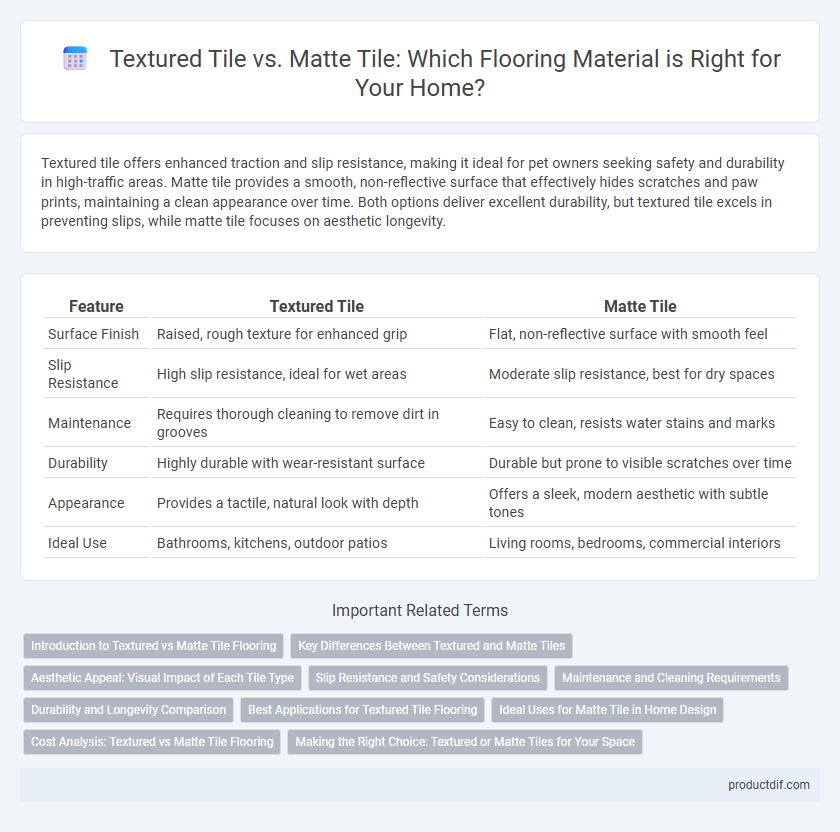Textured tile offers enhanced traction and slip resistance, making it ideal for pet owners seeking safety and durability in high-traffic areas. Matte tile provides a smooth, non-reflective surface that effectively hides scratches and paw prints, maintaining a clean appearance over time. Both options deliver excellent durability, but textured tile excels in preventing slips, while matte tile focuses on aesthetic longevity.
Table of Comparison
| Feature | Textured Tile | Matte Tile |
|---|---|---|
| Surface Finish | Raised, rough texture for enhanced grip | Flat, non-reflective surface with smooth feel |
| Slip Resistance | High slip resistance, ideal for wet areas | Moderate slip resistance, best for dry spaces |
| Maintenance | Requires thorough cleaning to remove dirt in grooves | Easy to clean, resists water stains and marks |
| Durability | Highly durable with wear-resistant surface | Durable but prone to visible scratches over time |
| Appearance | Provides a tactile, natural look with depth | Offers a sleek, modern aesthetic with subtle tones |
| Ideal Use | Bathrooms, kitchens, outdoor patios | Living rooms, bedrooms, commercial interiors |
Introduction to Textured vs Matte Tile Flooring
Textured tile flooring features raised patterns or surface variations that enhance grip and add visual depth, making it ideal for high-traffic or wet areas. Matte tile flooring offers a smooth, non-reflective finish that minimizes glare and hides scratches or dirt, providing a subtle and contemporary aesthetic. Both options vary in slip resistance and maintenance needs, influencing their suitability for different residential or commercial spaces.
Key Differences Between Textured and Matte Tiles
Textured tiles feature raised patterns or surfaces that enhance grip and provide a tactile experience, making them ideal for wet or high-traffic areas where slip resistance is crucial. Matte tiles offer a smooth, non-reflective finish with subtle texture, promoting a sleek and modern aesthetic while minimizing glare and visible dirt. Key differences include the level of surface relief and slip resistance, with textured tiles prioritizing functionality and safety, whereas matte tiles emphasize understated elegance and easy maintenance.
Aesthetic Appeal: Visual Impact of Each Tile Type
Textured tiles offer a dynamic visual impact with their raised patterns and intricate designs, adding depth and tactile interest to flooring surfaces. Matte tiles provide a smooth, non-reflective finish that creates a subtle and understated aesthetic, enhancing modern and minimalist interiors. Both options influence the room's ambiance, with textured tiles drawing attention through detail and matte tiles emphasizing muted elegance.
Slip Resistance and Safety Considerations
Textured tile offers enhanced slip resistance due to its uneven surface, making it ideal for areas prone to moisture or heavy foot traffic. Matte tile provides moderate slip resistance with a smooth finish that reduces glare but may be less effective in wet conditions. Prioritizing safety, textured tiles are preferable in kitchens and bathrooms where water exposure increases the risk of slipping.
Maintenance and Cleaning Requirements
Textured tile offers enhanced slip resistance but requires more frequent and thorough cleaning to prevent dirt buildup within its grooves, often needing specialized brushes or pressure washing. Matte tile hides smudges and water spots better, making daily cleaning easier with standard mopping and mild detergents, though it may show scratches over time. Both types benefit from regular sealing to maintain appearance and prolong durability, with textured tile demanding more attentive maintenance due to its surface complexity.
Durability and Longevity Comparison
Textured tiles offer enhanced slip resistance and better wear resistance due to their surface patterns, making them ideal for high-traffic areas prone to scratches and scuffs. Matte tiles, while providing a more subdued appearance, can be equally durable but may show stains and marks more easily over time, requiring more frequent maintenance to preserve their look. Both textured and matte tiles are crafted from similar durable materials like porcelain or ceramic, ensuring long-lasting performance when properly installed and cared for.
Best Applications for Textured Tile Flooring
Textured tile flooring is ideal for high-traffic areas and outdoor spaces due to its enhanced slip resistance and durability. This type of tile excels in kitchens, bathrooms, and commercial settings where safety and moisture control are critical. Its surface provides better traction compared to matte tiles, making it suitable for environments prone to wet conditions.
Ideal Uses for Matte Tile in Home Design
Matte tile is ideal for high-traffic areas like kitchens, bathrooms, and entryways due to its slip-resistant surface and ability to hide dirt and smudges. Its understated finish complements modern, minimalist, and contemporary design styles by providing a smooth, non-reflective look that enhances the overall aesthetic. Matte tiles work well on floors and walls where a subtle, elegant appearance is desired without the glare of glossy alternatives.
Cost Analysis: Textured vs Matte Tile Flooring
Textured tile flooring typically costs 10-20% more than matte tile due to additional manufacturing processes that create surface patterns enhancing slip resistance. Matte tiles offer budget-friendly options with consistent pricing across various materials, making them ideal for large-scale installations seeking affordability. Installation costs for both tile types remain similar, but textured tiles may require more labor time, increasing overall expenses marginally.
Making the Right Choice: Textured or Matte Tiles for Your Space
Textured tiles offer enhanced slip resistance and a distinctive tactile feel, making them ideal for high-traffic or wet areas where safety is a priority. Matte tiles provide a smooth, non-reflective surface that minimizes glare and hides dirt, perfect for modern, minimalist interiors seeking subtle sophistication. Consider the space's functionality and style preferences to determine whether the durability and grip of textured tiles or the understated elegance and ease of maintenance of matte tiles best suit your flooring needs.
Textured Tile vs Matte Tile Infographic

 productdif.com
productdif.com